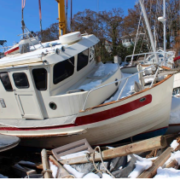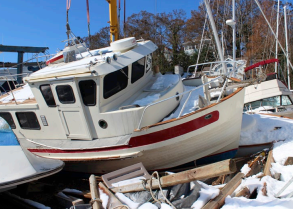BoatU.S. Tips For Protecting Boats in Hurricanes
(June 23rd, 2016) – What can you do to increase the odds of your boat surviving a hurricane? Quite a bit, actually. After every hurricane starting with Alicia in 1983, Boat Owners Association of the United States (BoatU.S.) has been evaluating what worked and what didn’t and sharing those lessons with boaters. The BoatU.S. Insurance claim files show that in most cases, boats are safer out of the water in hurricane conditions. When a hurricane watch is issued, BoatU.S. recommends that, if at all possible, you load your boat on its trailer and move it inland or have your boat hauled out. Whatever your current plan, there are five steps you should take before the next hurricane warning to give your boat the best chance of making it through the storm and to protect yourself if it doesn’t.
1 Find a safe place to store your boat when a hurricane threatens. Hurricanes pack wind speeds of 70 to 130 mph; winds in excess of 200 mph have been recorded. But strong winds are not the only risk to think about when storing your boat in a tropical storm. Hurricanes can create destructive waves when blowing over open water for less than a quarter-mile. Six to 12 inches of rainfall in 24 hours is normal, and 24 inches in 24 hours have been recorded. You should consider looking for another place to keep your boat in a tropical storm if your current location does not have any natural protection from the wind, is exposed to open water in any direction, or could be prone to flooding. But, as Superstorm Sandy so clearly demonstrated, the biggest danger comes from storm surge, extreme high water levels that can be 10 feet or more above the highest high tide. NOAA’s Sea, Lake, and Overland Surges from Hurricanes (SLOSH) model lets you look at the highest water level recorded in your area from storm surges in past storms (see online resources on back). You can use the maximum surge height to evaluate how secure your boat would be in a hurricane. If your boat’s on a floating dock, are the pilings high enough? Or would the surge float the docks off the pilings? If the marina or boat club is protected by a seawall, would water come over it? How high would the water be in the hardstand area? High enough to lift your boat off its jackstands? Would there be waves where boats are stored ashore? If you’re not happy with the answers, try to find another place to keep your boat during a storm.
2 Determine where to get the most accurate forecasts for wind and surge. Once a storm is approaching, your exact preparations will depend upon the forecast for wind and surge in your area. The National Hurricane Center provides the most complete and current information on potential wind speeds and probable tracks. The National Weather Service’s Probabilistic Hurricane Inundation Surge Height (PHISH) model (see online resources) forecasts surge heights when a hurricane is threatening an area. Sign up now to get hurricane alerts sent directly to your inbox from the BoatU.S. Hurricane Center (www.BoatUS/hurricanes).

3 If you keep your boat in a marina, get a copy of your marina’s hurricane plan and review it carefully. You need to understand your obligations, and theirs. To see some sample hurricane plans from marinas around the country, visit the BoatU.S. Hurricane Center.
4 Create your own hurricane plan. Stripping off sails and canvas, doubling lines on boats left in the water, lengthening scope on moorings, and tying the boat down if it’s on land can make the difference between a boat surviving a storm and not. The BoatU.S. Hurricane Center details hardwon lessons learned on how to secure your boat including a downloadable hurricane preparation worksheet. Use that to think through what you will need to do when a watch is issued.
5 Check your insurance policy for hurricane haulout, salvage, wreck removal, and fuel-spill coverages. Read the fine print in your insurance policy to make sure you’re covered before and after the storm. Some insurers will pay part of the cost of having a professional move or prepare your boat once a hurricane watch is issued. The best policies cover the cost of salvage without deducting it from the payment to you for damages to the boat. They also provide additional coverage for wreck removal and fuel spills under the policy’s liability provisions.

Before the Storm:
- Relocate the boat if necessary and secure it as outlined in your hurricane plan.
- Check that deck scuppers and drains are open and unobstructed, and the boat is positioned so that rainwater will drain from the deck and cockpit
- Reduce windage as much as possible by removing sails and canvas as well as dodger and bimini frames
- Clear the decks of anything that can blow away, including deck chairs and cushions, jerry cans, watersports equipment, dinghies, small outboards, and fishing equipment
- Make the boat watertight – seal any openings where water could get into the interior or the engine, including hatches, portlights, ventilators, and exhaust outlets
- Close interior seacocks/valves including those for the engine, toilet, and sinks
- Top up batteries and ensure that any electric bilge pumps are operational; clean all debris out of the bilge to prevent clogging of the pumps
- Remove all valuables from the boat including electronics and fishing equipment as well as registration and other important documents and store them at home
- Limit potential environmental damage by removing portable gasoline tanks, oil containers, paint cans, and other hazardous chemicals
- Lock the boat, but if the boat is in a marina, be sure to leave a spare key with the marina manager so he/she can get aboard after the storm if necessary
- Update all contact information with your marina manager and ask how you will be informed when you can return to your boat
After the Storm:
- If your boat is in a marina, access is likely to be restricted until the immediate dangers have been addressed; for your own safety, don’t attempt to enter before the restrictions are lifted
- Once you know the status of your boat, contact your insurance company if you need to file a claim; be sure to alert them to any potential environmental hazards
- Take a complete set of photos of the boat’s situation and any visible damage
- If possible, secure the boat against further damage or ask your marina to do so
- If there is any chance water has gotten into the engine, have it flushed and pickled as soon as possible
- Dry water-damaged areas and items as soon as you get access to the boat to limit mold growth
- If you are insured and your boat needs to be salvaged, do not sign any contracts or make any agreements; inform your insurance company and let them negotiate with the marina or salvor






